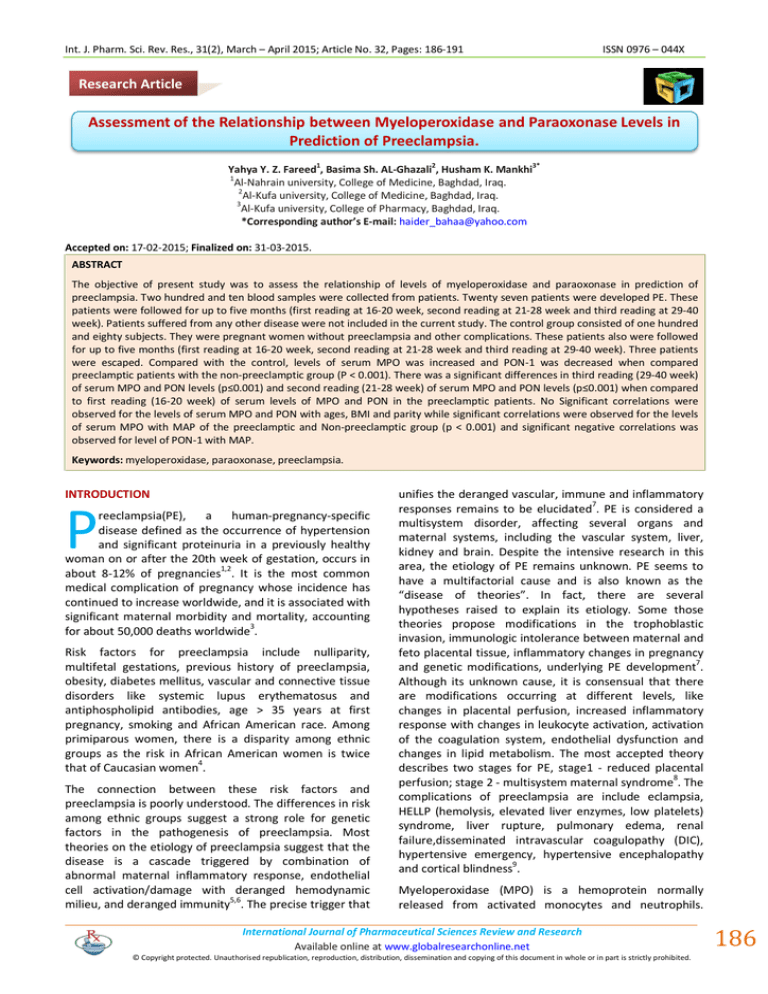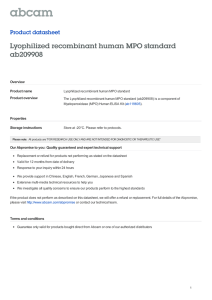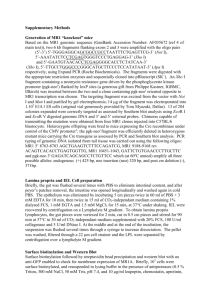Document 13310365
advertisement

Int. J. Pharm. Sci. Rev. Res., 31(2), March – April 2015; Article No. 32, Pages: 186-191 ISSN 0976 – 044X Research Article Assessment of the Relationship between Myeloperoxidase and Paraoxonase Levels in Prediction of Preeclampsia. 1 2 3* Yahya Y. Z. Fareed , Basima Sh. AL-Ghazali , Husham K. Mankhi 1 Al-Nahrain university, College of Medicine, Baghdad, Iraq. 2 Al-Kufa university, College of Medicine, Baghdad, Iraq. 3 Al-Kufa university, College of Pharmacy, Baghdad, Iraq. *Corresponding author’s E-mail: haider_bahaa@yahoo.com Accepted on: 17-02-2015; Finalized on: 31-03-2015. ABSTRACT The objective of present study was to assess the relationship of levels of myeloperoxidase and paraoxonase in prediction of preeclampsia. Two hundred and ten blood samples were collected from patients. Twenty seven patients were developed PE. These patients were followed for up to five months (first reading at 16-20 week, second reading at 21-28 week and third reading at 29-40 week). Patients suffered from any other disease were not included in the current study. The control group consisted of one hundred and eighty subjects. They were pregnant women without preeclampsia and other complications. These patients also were followed for up to five months (first reading at 16-20 week, second reading at 21-28 week and third reading at 29-40 week). Three patients were escaped. Compared with the control, levels of serum MPO was increased and PON-1 was decreased when compared preeclamptic patients with the non-preeclamptic group (P < 0.001). There was a significant differences in third reading (29-40 week) of serum MPO and PON levels (p≤0.001) and second reading (21-28 week) of serum MPO and PON levels (p≤0.001) when compared to first reading (16-20 week) of serum levels of MPO and PON in the preeclamptic patients. No Significant correlations were observed for the levels of serum MPO and PON with ages, BMI and parity while significant correlations were observed for the levels of serum MPO with MAP of the preeclamptic and Non-preeclamptic group (p < 0.001) and significant negative correlations was observed for level of PON-1 with MAP. Keywords: myeloperoxidase, paraoxonase, preeclampsia. INTRODUCTION P reeclampsia(PE), a human-pregnancy-specific disease defined as the occurrence of hypertension and significant proteinuria in a previously healthy woman on or after the 20th week of gestation, occurs in about 8-12% of pregnancies1,2. It is the most common medical complication of pregnancy whose incidence has continued to increase worldwide, and it is associated with significant maternal morbidity and mortality, accounting for about 50,000 deaths worldwide3. Risk factors for preeclampsia include nulliparity, multifetal gestations, previous history of preeclampsia, obesity, diabetes mellitus, vascular and connective tissue disorders like systemic lupus erythematosus and antiphospholipid antibodies, age > 35 years at first pregnancy, smoking and African American race. Among primiparous women, there is a disparity among ethnic groups as the risk in African American women is twice 4 that of Caucasian women . The connection between these risk factors and preeclampsia is poorly understood. The differences in risk among ethnic groups suggest a strong role for genetic factors in the pathogenesis of preeclampsia. Most theories on the etiology of preeclampsia suggest that the disease is a cascade triggered by combination of abnormal maternal inflammatory response, endothelial cell activation/damage with deranged hemodynamic milieu, and deranged immunity5,6. The precise trigger that unifies the deranged vascular, immune and inflammatory responses remains to be elucidated7. PE is considered a multisystem disorder, affecting several organs and maternal systems, including the vascular system, liver, kidney and brain. Despite the intensive research in this area, the etiology of PE remains unknown. PE seems to have a multifactorial cause and is also known as the “disease of theories”. In fact, there are several hypotheses raised to explain its etiology. Some those theories propose modifications in the trophoblastic invasion, immunologic intolerance between maternal and feto placental tissue, inflammatory changes in pregnancy and genetic modifications, underlying PE development7. Although its unknown cause, it is consensual that there are modifications occurring at different levels, like changes in placental perfusion, increased inflammatory response with changes in leukocyte activation, activation of the coagulation system, endothelial dysfunction and changes in lipid metabolism. The most accepted theory describes two stages for PE, stage1 - reduced placental perfusion; stage 2 - multisystem maternal syndrome8. The complications of preeclampsia are include eclampsia, HELLP (hemolysis, elevated liver enzymes, low platelets) syndrome, liver rupture, pulmonary edema, renal failure,disseminated intravascular coagulopathy (DIC), hypertensive emergency, hypertensive encephalopathy and cortical blindness9. Myeloperoxidase (MPO) is a hemoprotein normally released from activated monocytes and neutrophils. International Journal of Pharmaceutical Sciences Review and Research Available online at www.globalresearchonline.net © Copyright protected. Unauthorised republication, reproduction, distribution, dissemination and copying of this document in whole or in part is strictly prohibited. 186 © Copyright pro Int. J. Pharm. Sci. Rev. Res., 31(2), March – April 2015; Article No. 32, Pages: 186-191 Traditionally viewed as a microbicidal enzyme, MPO also induces low-density lipoprotein oxidation, activates metalloproteinases, and oxidatively consumes endothelium-derived NO. The elevated plasma MPO level is a risk factor for myocardial events in patients with coronary artery disease10. Patients with preeclampsia display evidence of the inflammation and endothelial dysfunction associated with oxidative stress in the circulation, vasculature, and placenta We hypothesized that MPO levels in the circulation and placental extracts from women with preeclampsia would be different from levels in women with normal pregnancies11. Paraoxonase is associated in human serum with high density lipoprotein (HDL). Paraoxonase protects low density lipoprotein and HDL from oxidation. This protection is probably related to the ability of paraoxonase to hydrolyze some oxidized phospholipids12 and/or 13 cholesteryl linoleate hydroperoxides . Serum paraoxonase activity was found to be reduced in a number of pathological conditions, including myocardial infarction, diabetes and hypercholesterolemia. Previous studies showed decreased serum paraoxonase activity in cases of preeclampsia14,15. METHOD Two hundred and ten blood samples were collected from patients admitted to AL- Zahraa Teaching Hospital during the period from June 2013 to January 2014. Twenty seven patients were developed PE later on after follow up. Their ages range from 21-38 years. These patients were followed for up to five months (first reading at 16-20 week, second reading at 21-28 week and third reading at 29-40 week) for serial assessment for estimation of serum levels of MPO and PON-1 in the PE patients. Patients suffered from any other disease were not included in the current study. Control group consisted of one hundred and eighty subjects. They were pregnant women without preeclampsia and other complications. The control group samples were collected from AL- Zahraa Teaching Hospital in Annajaf City. These patients also were followed for up to five months (first reading at 16-20 week, second reading at 21-28 week and third reading at 29-40 week). Their ages range from 21-36 years. Blood samples were obtained from pregnant women with preeclampsia and Non-PE groups by vein puncture. Samples were allowed to clot at room temperature for 30 minutes, and then centrifuged at 3000 Xg for 20 minutes. Sera were removed and stored at -18 °C until analysis in disposable serum tubes. RESULTS The evaluation of the data indicated that the enrolled patients were distributed according to different trends. They were distributed according to the age, Parity, BMI and MAP. The characteristics of the enrolled preeclamptic patients are mentioned in Table (1, 2 and 3) by mean and the standard deviation (Mean ± SD). There was significant (p < 0.001) elevation of the concentrations of MPO in preeclamptic patients when compared with those of the ISSN 0976 – 044X non-preeclamptic group and there was significant (p < 0.001) decreasing the concentrations of PON in preeclamptic patients when compared with those of the non-preeclamptic group (Table 4) (A,B,C). 27 patients were followed up (the first reading from 16-20 week, the second reading from 21-28 week and the third reading from 29–40 week) for serial assessment of serum levels estimation of MPO and PON in preeclamptic patients (Table 4). The linear regression analysis was used to examine the relationship of the levels of MPO and PON with ages of the preeclamptic and Non-preeclamptic group. No significant correlations were observed for the levels of MPO and PON with ages of the preeclamptic and Nonpreeclamptic group. The linear regression analysis was used to examine the relationship of the levels of MPO and PON with MAP of the preeclamptic and Non-preeclamptic group. Significant positive correlations (Table 5 and Figure 1) were observed for the levels of MPO while significant negative correlations (Table 5 and Figure 2) were observed for the level of PON with MAP of the preeclamptic. The linear regression analysis pointed out significant negative correlation between MPO with PON in preeclamptic patients (Figure 3) Table 1: Characteristics of preeclamptic patients (16-20 week) included in the study. Variable Mean ± SD Range Age (years) 28.93 ± 5.45 21-38 2 Body mass index (kg/m ) 24.26 ± 2.61 20-29 Systolic pressure (mmHg) 116.44 ± 6.57 97-124 Diastolic pressure (mmHg) 75.26 ± 5.76 65-86 Mean arterial pressure (mmHg) 88.99 ± 5.04 78.3-98 Parity 2.26 ± 1.23 0-6 Table 2: Characteristics of preeclamptic patients (21-28 week) included in the study. Variable Mean ± SD Age (years) 28.93 ± 5.45 Range 21-38 Body mass index (kg/m2) 25.16 ± 2.15 20-30.16 140-170 Systolic pressure (mmHg) 151.16±7.45 Diastolic pressure (mmHg) 97.56 ± 6.33 90-114 Mean arterial pressure(mmHg) 108.05 ± 4.11 106-118.6 Parity 2.26 ± 1.23 0-6 Table 3: Characteristics of preeclamptic patients (21-40 week) included in the study. Variable Mean ± SD Age (years) 28.93 ± 5.45 21-38 Body mass index (kg/m ) 27.31 ± 2.06 22.2-33 145-172 2 Range Systolic pressure (mmHg) 152.24 ± 6.07 Diastolic pressure (mmHg) 98.04 ± 4.41 89-115 Mean arterial pressure (mmHg) 118.45 ± 4.13 106.7-126.6 Parity 2.26 ± 1.23 0-6 International Journal of Pharmaceutical Sciences Review and Research Available online at www.globalresearchonline.net © Copyright protected. Unauthorised republication, reproduction, distribution, dissemination and copying of this document in whole or in part is strictly prohibited. 187 © Copyright pro Int. J. Pharm. Sci. Rev. Res., 31(2), March – April 2015; Article No. 32, Pages: 186-191 Table 4A: Serum MPO and PON levels in preeclamptic patients and the non-preeclamptic group (16-20 week). Parameter Subject NO. Mean ± SD Range MPO PE 27 26.79 ± 0.92 25.3-28.6 ng/ml NON-PE 180 14.71 ± 2.37 11.2-20.7 PON PE 27 156.41 ± 6.59 147-171 mIU/ml NON-PE 180 187.67 ± 10.35 169-211 P-value < 0.001 < 0.001 Note: P-value < 0.001 mean significant Table 4B: Serum MPO and PON levels in preeclamptic patients and the non-preeclamptic group (21-28 week). Parameter Subject NO. Mean ± SD Range MPO PE 27 31.39 ± 1.16 29.1 - 33.2 ng/ml NON-PE 180 14.81 ± 2.71 11.1 - 21.1 PON PE 27 145.44 ± 6.59 137 - 159 mIU/ml NON-PE 180 184.77 ± 9.14 169 - 209 Pvalue < 0.001 < 0.001 Table 4C: Serum MPO and PON levels in preeclamptic patients and the non-preeclamptic group (29-40 week). Parameter Subject NO. Mean ± SD Range MPO PE 27 36.27 ± 0.76 34.5 - 37.8 ng/ml NON-PE 180 14.90 ± 2.22 10.9 - 19.7 PON PE 27 134.52 ± 6.57 124 - 146 mIU/ml NON-PE 180 181.13 ± 9.97 163 - 204 P-value < 0.001 < 0.001 Table 5A: Serial assessment of serum levels of MPO and PON in 27 preeclamptic patients Parameter First Reading Second Reading Third Reading 16-20 week 21-28 week 29-40 week 36.27 ± 0.76 MPO 26.79 ± 0.92 31.39 ± 1.16 ng/ml A A* A* PON 156.41 ± 6.59 145.44 ± 6.59 134.52 ± 6.57 mIU/ml D D* D* Table 5B: Univariate analysis of MPO and PON with MAP of preeclamptic patients and Non-preeclamptic group. Preeclamptic Non-Preeclamptic Parameter r P r P MPO (ng/ml) 0.36 < 0.001 0.03 N.S PON (mIU/ml) 0.34 < 0.005 0.07 N.S Figure 1: The correlation of MAP with MPO in: A) preeclamptic patients ISSN 0976 – 044X DISCUSSION When the results of MPO and PON-1 concentrations of patients were compared with the control group, the highest levels of the control group were 28.6 ng/ml and 171mlU/ml respectively, the lowest values of MPO and PON-1 concentrations in the group of patients were 25.3ng/ml and 147mlU/ml respectively. Thus it is clear that only the values of MPO of the patients and the control group did not overlap, in contrast PON-1 do not do so. These evidences suggest the use of measurements of MPO concentration as additional parameters in the management and prediction of PE. We can suggest a cut off value for MPO after more investigations. No Significant correlations were observed for the sera level of MPO and PON-1with ages of patients and the control 16 group. These results are in agreement with Schwartz LB who found that there are no significant changes in serum MPO with respect to maternal age. The current results indicated that alterations of inflammatory markers in PE are independent on ages of patients. The reasons seem to be unclear and further investigations may be required to explain such reasons16. The linear regression analysis was used to examine the relationship of the levels of MPO and PON-1 with mean arterial pressure (MAP) of the patients and the control group. Significant positive correlations were observed for the level of MPO and PON-1 with the mean arterial pressure (MAP) of the patients, significant correlations could not be obtained in the group of healthy pregnant women. These results are in agreement with those reported by Shakow S.17 who found that in hypertensive pregnant women there is a release of placental factors that initiate a cascade of cellular and molecular events leading to endothelial and vascular smooth muscle cell dysfunction and thereby increased vascular resistance and arterial pressure. It was found a positive correlation between serum levels of MPO and diastolic and systolic blood pressure in PE. Endothelial dysfunction of PE has been associated with an exaggerated maternal inflammatory response to pregnancy. It has been hypothesized that placental hypoxia resulting from uteroplacental arterial insufficiency, amplifies the release of inflammatory stimuli into the maternal circulation18. Carreras L. showed that MPO can induce endothelial dysfunction and injury to ultra structure of placenta and umbilical vascular endothelium. This injury may play a role in the pathogenesis of pregnancy induced hypertension18. Figure 2: The correlation of MAP with PON in: A) preeclamptic patients Figure 3: The correlation of MPO with PON in preeclamptic patients International Journal of Pharmaceutical Sciences Review and Research Available online at www.globalresearchonline.net © Copyright protected. Unauthorised republication, reproduction, distribution, dissemination and copying of this document in whole or in part is strictly prohibited. 188 © Copyright pro Int. J. Pharm. Sci. Rev. Res., 31(2), March – April 2015; Article No. 32, Pages: 186-191 Level of MPO in Preeclampsia In the current study, MPO levels were significantly increased in women with preeclampsia. Serum MPO levels have been shown to increase with gestational age 19 in the preeclamptic patients. This agreement with who showed MPO levels were significantly elevated in women with PE when compared with samples without preeclampsia. Serum MPO levels in patients with preeclampsia were contributed to the oxidative damage reported in the endothelium of women with preeclampsia. MPO can become sequestered in the subendothelial space through a process of endothelial transcytosis, resulting in the accumulation of MPO in the endothelial cell matrix. There it can be a potent source of reactive oxygen and nitrogen species. This disagreement 20 with who found no significant difference in baseline serum MPO levels between PE and Non-PE patients. Mast cells play a key role in allergic reactions and increase in numbers under inflammatory conditions. Extracellular tryptase, when present, may be a marker of mast cell activation in disease interestingly, increased MPO activity was observed in preeclamptic group. This observation could be explained to result of a study that reported by Cregar.21 These authors reported that MPO inhibits human mast cell tryptase in a time dependent manner. It is the native protein conformation of MPO and not its enzyme activity that is responsible for tryptase inhibition21. In the current study, MPO has negative correlation with PON and positive correlation with luekotrienes, this agreement with22. Preeclampsia is proposed as a two-stage disorder: reduced placental perfusion usually results with an abnormal implantation and a maternal disorder characterized by endothelial dysfunction and subsequent pathophysiological changes. Reduced perfusion and abnormal implantation could be seen in IUGR or preterm labor without the maternal syndrome. This leads to the hypothesis that reduced placental perfusion must interact with maternal constitutional factors especially some immuno-genetic dysfunctions to generate the systemic 23 pathophysiology of preeclampsia . Oxidative stress secondary to reduced placental perfusion leads to endothelial dysfunction. MPO is an oxidative enzyme and could link the two stages of preeclampsia. Pregnancy is associated with an inflammatory state, and inflammatory changes with neutrophil activation are exacerbated in preeclampsia (Holthe MR., 2005). Activated leukocytes, both monocytes and granulocytes which expressed MPO enzyme, generate excess reactive oxygen species 24 resulting in oxidative stress . MPO is an oxidative enzyme that is abundantly expressed in the azurophilic granules of neutrophils and to a lesser extent in monocytes. MPO reacts with H2O2. MPO–H2O2 complex forms HOCl, OCl, and Cl2. HOCl is the potent oxidant in 25 the active neutrophiles . The toxicity of H2O2 increases after it reacts with MPO. Another potentially important affect of MPO activity is consumption of nitric oxide and induction of endothelial dysfunction. MPO serves as a ISSN 0976 – 044X catalytic sink for nitric oxide, impairs nitric oxide dependent vasodilation, and decreases nitric oxide bioavailability in cultured cells26. Serum MPO levels serve as a strong and independent predictor of endothelial dysfunction in human subjects. They concluded that MPO-mediated endothelial dysfunction may be an important mechanistic link between oxidationinflammation which have an important role of etiopathogenesis of preeclampsia and cardiovascular disease. Previously Bowen have reported that the serum concentration of MPO did not change in preeclampsia and eclampsia compared with normal pregnancy. Lastly, Gandley have demonstrated that MPO levels were significantly increased in the circulation of women with preeclampsia. Kim performed the study to determine whether genetic variability in oxidative stress-related enzymes contributes to individual preeclampsia 27,28 susceptibility differences in the Korean population Level of PON-1 in Preeclampsia In the present study, results indicated that serum PON activity was lower significantly in preeclamptic group compared to non-preeclamptic. This is agreement with29. PON1 is antioxidant enzyme located in HDL that protect vascular tissue from oxidative damage by protecting low density lipoprotein and HDL from oxidation and responsible of the antioxidant activity of HDL. This protection is probably related to the ability of paraoxonase to hydrolyze some oxidized phospholipids and/or cholesteryl linoleate hydroperoxides. Serum PON activity was found to be reduced in a number of pathological conditions including myocardial infarction, diabetes and pregnancy complication including PE12. Ceruloplasmin oxidase was higher in normal pregnancies in comparison to other groups with pregnancy complications. These results of PON was thought to offer the cell protection from the damage caused by the increased oxidative stress associated with PE. Ceruloplasmin (ferroxidase activity), like PON known as oxidant defense enzyme and decreases significantly in 17 pregnant women with complications . It has been suggested that an oxidant/antioxidant imbalance is associated with pregnancy failure. Increased oxidative stress may alter placental vasculature, the prostacyclin-thromboxane balance and culminating in PE. The decrease in PON1 activity may play an important role in pathogenesis of early PE detection through increased susceptibility to lipid peroxidation30. Muge31 concluded that patient with complete hydatidiform mole are exposed to oxidative stress, which may have a role in the pathogenesis of the disease. Serum paraoxonase and arylestrase activities decrease in preeclampsia, and this situation may be associated with increased LOOH in these patients. Lower PON activity investigated also in normal 32 30 pregnancy by Emre and in pregnancy failure by Harun. PON1has antiatherogenic and anti-inflammatory properties, resulting from its ability to destroy modified International Journal of Pharmaceutical Sciences Review and Research Available online at www.globalresearchonline.net © Copyright protected. Unauthorised republication, reproduction, distribution, dissemination and copying of this document in whole or in part is strictly prohibited. 189 © Copyright pro Int. J. Pharm. Sci. Rev. Res., 31(2), March – April 2015; Article No. 32, Pages: 186-191 phospholipids and to prevent accumulation of oxidized lipids in lipoproteins. LDL particles can be protected from free radical-induced oxidation by an HDL-linked enzyme PON1. Arylesterase (AE), one of the enzymatic activities of PON1, is known to play a protective role against peroxidation of LDL and other lipoproteins33. The decrease serum PON1 activity in PE patients may contribute to insulin resistance and atherosclerotic heart disease and/or the inactivation of the enzyme itself due to oxidative stress, hyperandrogenism, nonenzymatic glycation. Moreover, the impairment of PON1 activity may be the result of structural modification of Apo A-I, because Apo A-I is necessary to stabilize the structure of PON1 and maintain PON1 activity. However, under conditions of oxidative stress PON1 can be oxidized or undergoes nitration, when exposed to peroxynitrite (ONOO–) which leads to structural and 34 functional modification of Apo A-1 . The serum PON1 activity is affected by oxidative stress. PON1 activity is inhibited by reactive oxygen species and also, the serum PON1 expression is down-regulated by oxidative stress and this can explain the negative correlation between PON1 and MPO in PE34. REFERENCES ISSN 0976 – 044X 11. Jennifer Rohland, Yan Zhou, Eiji Shibata: Increased Myeloperoxidase in the Placenta and Circulation of Women with Preeclampsia. American Heart Association, 52, 2008, 387-393. 12. Watson AD, Berliner JA, Hama SY. Inhibition of the biological activity of minimally oxidized low-density lipoprotein. J Clin. Invest; 1999, 1432-1464. 13. Aviram M., Rosenblat M., Bisgaier CL. Paraoxonase inhibits high density lipoprotein (HDL) oxidation and preserves its functions. J Clin Invest, 101, 1998. 1581-1590. 14. Uzun H., Benian A., Madazli R. Circulating oxidized low density lipoprotein and paraoxonase activity in preeclampsia. Gynecol Obstet Invest, 60, 2005, 195-200. 15. Schwartz LB.: Tryptase from human mast cells: Neutral Proteases of Mast Cells; Monographs in Allergy. New York: S. Karger, 2009, 90–113. 16. Shakow S., Abbasali Z. and Rashtchi Zb. Serum Level and Antioxidant Activity of Ceruloplasmia in Preeclampsia; Pakistan J. of Biol. Science. 13, 2010, 621-627. 17. Carreras L. O., Defreyn G., Van E. Prostacyclin and preeclampsia; Lancet. 2008, 442. 18. Gandley RE., Rohlan J, Zhou Y: Increased myeloperoxidase in the placenta and circulation of women with preeclampsia; Hypertension. 52, 2011, 387–393. 1. Ghulmiyyah L. and Sibai B: Maternal mortality from preeclampsia/eclampsia. 36(1). 2012, 56-59. 19. Baldus S., Eiserich JP., Mani A Endothelial transcytosis of myeloperoxidase confers specificity to vascular ECM proteins as targets of tyrosine nitration; J Clin Invest. 2013. 2. Moodley Y Thrombophilia is significantly associated with severe preeclampsia: results of a large-scale, casecontrolled study; Hypertension. 46, 2012, 1270-1274. 20. Cregar L., Elrod KC. And Putnam D. Neutrophil myeloperoxidase is a potent and selective inhibitor of mast cell tryptase; Arch Biochem Biophys. 366(1), 2005, 125-130. 3. Duley L. The global impact of pre-eclampsia and eclampsia. 33(3), 2009, 130–137. 4. Rao A.K., Daniels K., El-Sayed Y. Y. and M. K. Moshesh American Journal of Obstetrics and Gynecology; Perinatal outcomes among Asian American and Pacific Islander women. 195(3), 2006, 834–838. 21. Ebru O., Ozcan B., Sacide P. Genetic Variation of Myeloperoxidase Gene Contributes to Preeclampsia: A Preliminary Association Study in Turkish Population; Hypertension in Pregnancy. 30, 2011, 377–383. 5. 6. 7. Steinberg G., Khankin E. V. and. Karumanchi S. A. Thrombosis Research; Angiogenic factors and preeclampsia. 123, 2009, S93–S99. Clifton V. L., Stark M. J., Osei-Kumah A. Review: the fetoplacental unit; pregnancy pathology and impact on long term maternal health. Placenta, 33, 2012, S37–S41. Elosha Eiland, Chike Nzerue and Marquetta Faulkner preeclampsia. Journal of Pregnancy, 2012, 7. 8. Cristina Catarino, Irene Rebelo, Luis Belo. Umbilical Cord Blood Changes in Neonates from a Preeclamptic Pregnancy. Journal of Pregnancy, 2009, 33-56. 9. Errol R. Norwitz, Chaur D., John T. Acute Complications of Preeclampsia. Clinical Obstetric and Gynecology, 45, 2002, 308-329. 10. Sugiyama S., Okada Y., Sukhova GK. Macrophage myeloperoxidase regulation by granulocyte macrophage colony-stimulating factor in human atherosclerosis and implications in acute coronary syndromes. Am J Pathol; 158, 2001, 879–891. 22. Roberts JM. And Hubel CA Is oxidative stress the link in the two-stage model of preeclampsia; Lancet. 354(7), 1999, 88–789. 23. Holthe MR., Staff AC., Berge LN. Leukocyte adhesion molecules and reactive oxygen species in preeclampsia; Obstet Gynecol. 103, 2009, 913–922. 24. Malle E., Furtmüller PG. and Sattler W. (2007): Myeloperoxidase: A target for new drug development; Brit J Pharmacol. 152, 838–854. 25. Abu-Soud HM., Khassawneh MY., Sohn JT. Peroxidases inhibit nitric oxide (NO) dependent bronchodilation: Development of a model describing NO-peroxidase interactions; Biochemistry. 40, 2011, 11866–11875. 26. Bowen RS., Moodley J., Dutton MF. Systemic inflammatory indices in preeclampsia and eclampsia; J Obstet Gynaecol. 21, 2010, 563–569. 27. Kim YJ., Park HS., Park MH. Oxidative stress-related gene polymorphism and the risk of preeclampsia; Eur J Obstet Gynecol Reprod Biol. 119, 2005, 42–46. 28. Israa Gh. And Zaizafoon N. Association between Serum Paraoxonase and Ceruloplasmin Oxidase in Iraqi Pregnant International Journal of Pharmaceutical Sciences Review and Research Available online at www.globalresearchonline.net © Copyright protected. Unauthorised republication, reproduction, distribution, dissemination and copying of this document in whole or in part is strictly prohibited. 190 © Copyright pro Int. J. Pharm. Sci. Rev. Res., 31(2), March – April 2015; Article No. 32, Pages: 186-191 Women With and Without Complications; Iosr Journal of Pharmacy. 2013, 29-34. 29. Harun T. and Hakan C. Assessment of Serum Paraoxonase and Arylestrase Activities in Early Pregnancy Failure; Swiss Med. Weekly. 139(5-6), 2009, 76-81. 30. Muge H., Mebmet H. and Ozcan E. Increased Oxidative Stress in Patients with Hydafidiform Mole; Swiss Med. Weekly. 133, 2003, 563-566. 31. Emre S. and Zehra S. Serum PON and Arylestrase Activities throughout the Normal Pregnancy; Nobel Med. 7(1), 2011, 49-55. ISSN 0976 – 044X 32. Olivier Piconne, Roland Asmar, and Jean-Marc Ayoubi: Preeclampsia: pathophysiology, diagnosis, and management. Vascular health and risk management. 7, 2011, 467–474. 33. Wójcicka G. Jamroz-Wiśniewska A., Marciniak A. The effect glibenclamide on paraoxonase 1 and platelet-glibenclamide on paraoxonase 1 and platelet-activating. 2010, 126-132. 34. Rozenberg O. and Aviram MS-Glutathionylation regulates HDL associated paraoxonase 1 (PON1) activity; Biochemical and Biophysical Research Communications. 351, 2006, 492498. Source of Support: Nil, Conflict of Interest: None. International Journal of Pharmaceutical Sciences Review and Research Available online at www.globalresearchonline.net © Copyright protected. Unauthorised republication, reproduction, distribution, dissemination and copying of this document in whole or in part is strictly prohibited. 191 © Copyright pro






